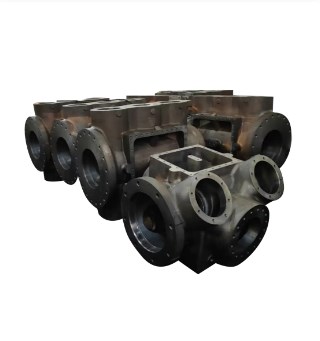-

+86-13404286222
-

hmjxboss@gmail.com

INQUIRE NOW

+86-13404286222

hmjxboss@gmail.com

INQUIRE NOW
Introduction to Jiangyin Huanming Machinery Co., Ltd.
2024-03-01The role of mechanical processing in the field of nuclear energy?
2024-03-18Introduction to the Application of Mechanical Processing in the Marine Industry?
2024-03-19How can mechanical processing improve the performance and reliability of wind turbines?
2024-03-26What are the applications of machining in the field of wind power metallurgy?
2024-03-27In modern industrial equipment systems, large compressors are crucial equipment in energy, chemical, metallurgical, shipbuilding, and power industries. The large compressor shaft rotor is one of the most critical core components of the entire compression system. Its precise structure, high manufacturing difficulty, and stringent technical requirements make it a key indicator of compressor performance and reliability. With continuous advancements in manufacturing processes and materials science, the design and manufacturing of large rotor shafts are developing towards higher efficiency, higher strength, and higher stability.
I. Structural Characteristics and Functional Positioning of the Compressor Rotor Shaft
The large compressor rotor shaft is the "heart" of the compressor, playing a vital role in driving impeller rotation, transmitting power, and maintaining system balance. It must not only withstand the centrifugal force from high-speed rotation but also resist complex loads such as gas pressure, axial thrust, and thermal expansion stress. Typically, the rotor shaft structure includes the main shaft body, impeller mounting area, coupling connection area, and bearing support section. The design of each part must achieve precise coordination between mechanical and dynamic balance.
Under high pressure and high flow conditions, the dynamic balance performance of the rotor shaft directly affects the vibration level and service life of the compressor. A high-quality rotor shaft design can significantly reduce mechanical losses, minimize energy loss, and improve the overall stability and operating efficiency of the compressor. High-precision dynamic balancing technology during manufacturing ensures that the rotor shaft maintains extremely low vibration amplitude even at high speeds, a crucial foundation for the long-term stable operation of modern high-end compressors.

II. Key Materials and Heat Treatment Technology Large compressor rotor shafts require extremely high material performance, possessing excellent strength and toughness, as well as good heat resistance and fatigue resistance. Currently, mainstream materials primarily utilize high-alloy steel, nickel-based alloys, or high-temperature alloys. Through optimized chemical composition and precision forging processes, these materials can ensure structural integrity and dimensional stability even under extreme operating conditions.
Heat treatment is a critical factor determining rotor shaft performance. Multiple heat treatment processes, such as tempering, surface quenching, nitriding, or low-temperature tempering, can significantly improve the strength and hardness distribution of the shaft core, enhancing its wear resistance and crack resistance. Especially in large centrifugal or reciprocating compressors, the distribution of thermal stress is extremely uneven. Therefore, proper control of heat treatment parameters is crucial to prevent structural deformation and crack formation.
III. Precision Machining and Dynamic Balancing Control
The manufacturing process of a large compressor shaft rotor requires extremely high machining precision. Due to the large length, heavy weight, and complex structure of the rotor shaft, even the slightest deviation during machining can lead to final assembly imbalance, thus affecting the dynamic performance of the entire compression system. Modern manufacturing enterprises generally adopt integrated processes of five-axis CNC milling and turning, CNC grinding, and dynamic balancing testing to ensure that every dimension and geometric tolerance is within the micrometer range.
In terms of dynamic balancing control, a highly sensitive dynamic testing system is used. Through multi-segment weighted correction and real-time monitoring, the vibration amplitude of the rotor is ensured to remain stable within an extremely low range when operating at rated speed. This technology not only improves the energy efficiency of the equipment but also effectively extends the service life of bearings and sealing components, reducing maintenance costs.
IV. Surface Engineering and Fatigue Resistance Strengthening
With the increasing complexity of the compressor operating environment, the protection and strengthening technology of the rotor shaft surface is particularly important. Advanced surface treatment processes such as plasma spraying, laser cladding, or ion nitriding can form a high-hardness, low-friction, and corrosion-resistant composite protective layer on the rotor shaft surface, significantly improving its wear resistance and fatigue life.
Especially in compressor systems operating in high-temperature and high-pressure media, the shaft surface is often subjected to gas corrosion or particle wear. Therefore, surface densification and strengthening treatments are crucial for extending the rotor's service life. Through material surface structure optimization and residual stress control, crack initiation and propagation can be effectively suppressed, ensuring the rotor maintains stable performance under long-term high-load conditions.

V. Manufacturing Inspection and Quality Assurance System Quality control of large compressor rotor shafts is maintained throughout the entire manufacturing cycle. From raw material intake to final assembly and shipment, rigorous inspection procedures are essential. Ultrasonic testing, magnetic particle testing, and X-ray non-destructive testing are widely used to ensure the internal structure is free of defects and inclusions and to verify the uniformity of the microstructure after heat treatment.
Geometric dimensional inspection is equally critical. Through laser measurement and coordinate measuring machine (CMM) technology, the entire process of monitoring shaft coaxiality, circular runout, and surface roughness can be achieved, ensuring that every detail meets design standards. This comprehensive testing system not only guarantees the safety and reliability of the rotor shaft but also provides a solid guarantee for the efficient operation of the compressor system.
As a core component of high-end compressor systems, the design and manufacturing level of a large compressor shaft represents a nation's technological strength in high-end equipment manufacturing. With continuous advancements in materials science, processing technology, and intelligent manufacturing, future large rotor shafts will evolve towards higher precision, higher strength, and greater intelligence, providing continuous power for the efficient and safe operation of global energy and industrial systems.
 No. 16 Dayuanli Road, Yunting Street, Jiangyin City, Jiangsu Province, China
No. 16 Dayuanli Road, Yunting Street, Jiangyin City, Jiangsu Province, China
 +86-13404286222 / +86-13404286222
+86-13404286222 / +86-13404286222
 +86-510-86668678
+86-510-86668678
 hmjxboss@gmail.com
hmjxboss@gmail.com
Copyright © Jiangyin Huanming Machinery Co., Ltd. All Rights Reserved.Custom Large Components Mechanical Processing Manufacturers
